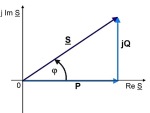Voltage provided by Wind turbines must comply some requirements specified in the IEC 61400-21 standard. Here we are some power quality parameters that power energy from wind turbines must be under control:
Rated Data
- Rated Power (Pn) (or Active Power): Maximum continuous electric output power for a wind turbine under operating conditions.
- Rated Reactive Power (Qn): Reactive power under rated power, nominal voltage and frequency.
- Rate Apparent Power (Sn): Apparent power from the wind turbine while operating at rated power and nominal voltage and frequency.
- Rated Current (In): Current from the wind turbine while operating at rated power and nominal voltage a frequency.
Maximum Permitted Power (Pmc)
It is the 10-minute average power from a wind turbine. Wind turbines with active control of output power (blade pitching and/or speed control) typically provide Pmc = Pn. Wind turbines with passive control of output power (fixed-speed or stall-controlled wind turbines) are fixed with Pmc some 20% higher than Pn.
Maximum Measured Power (P60 and P0.2)
Maximum measured power as a 60 and 0,2 seconds average value. They can be used as protection settings. For variable-speed wind turbines P0,2=P60=Pn. For fixed-speed wind turbines, stall or pitch controlled P0,2 > Pn.
Reactive Power (Q)
It must be specified as a 10-minute average value as a function of 10%,…, 90%, 100% of Pn, Pmc, P60 and P0,2. Wind turbines employing modern frequency converters can control the Reactive Power (Q) to zero (depending by the size of the converter.)
Flicker Coefficient c(Ψk, νa)
Power fluctuations in wind turbines can have several consequences in the grid. Therefore, it is important to measure these fluctuations, “flickers”, with a flickermeter and to fulfill the IEC 61000-4-15 standard. Variable-speed wind turbines have usually low flicker coefficients, whereas fixed-speed wind turbines swing from average (stall-controlled) to high coefficients (pitch-controlled). The formula is;
Where;
- Ψk: Network impedance phase angle.
- νa: Annual average wind speed.
- Pst : Flicker emission from the wind turbine.
- Sn: Rated apparent power of the wind turbine.
- Sk: Short-circuit apparent power of the grid.
Maximum Number of Wind Turbine Switching Operations (N10 and N120).
The following switch operations may cause voltage variations:
- Start-up at cut-in wind speed.
- Start-up at rated wind speed.
- Switching between generators (measurement of the worst case) in the case the wind turbine has more than one generator. So, N10 is the maximum number of the switching operation within 10-minutes period and N120 within 2-hour period.
Flicker Step Factor Kf(Ψk)
It is the flicker emission due to a single switching operation of a wind turbine.
- Tp Duration of the voltage variation due to the switching operation.
Similar to the flicker coefficient, variable-speed wind turbines have low Flicker Step Factors, whereas values for fixed-speed wind turbines swing from average (pitch-controlled) to high (stall-controlled).
Voltage Change Factor Ku(Ψk)
It is the voltage change caused by a single switching operation of a wind turbine.
- Umax and Umin: Maximum and minimum voltage (Root Mena Square (RMS) phase-to-neutral) due to the switching.
- Un: Nominal phase-to-phase voltage.
Therefore, variable-speed wind turbines have low Voltage Change Factors, whereas values for fixed-speed wind turbines swing from average (pitch-controlled) to high (stall-controlled).
Maximum Harmonic Currents (Ih)
It is the emission of harmonic currents of a wind turbine with an electronic converter. However, IEC 61400-21 does not require measurement of harmonic emissions from induction machines#mce_temp_url# with power electronic converters (Type A and B).
Tags: Asynchronous (Induction), Frequency Converter, Generators, Power, Requirements, Synchronous, Theory, Wind Turbines




Leave a comment